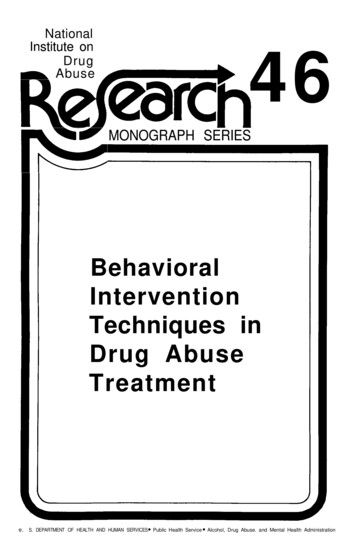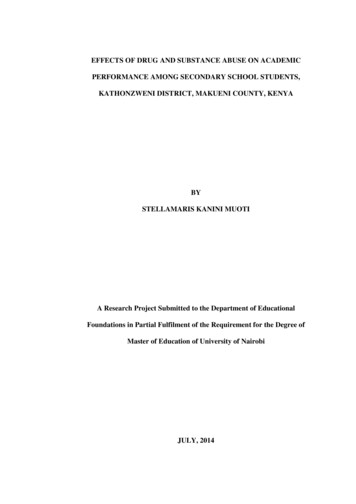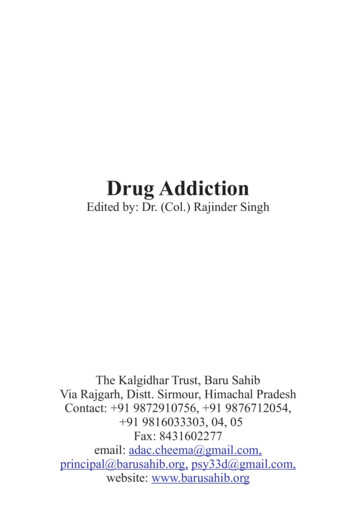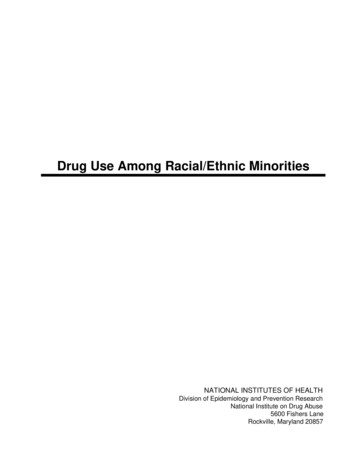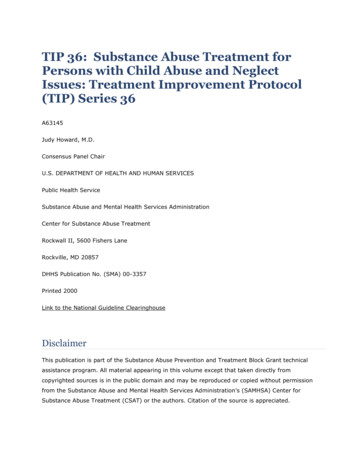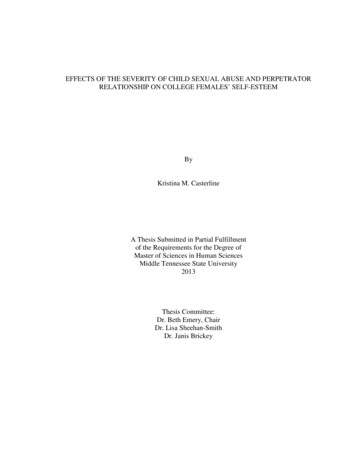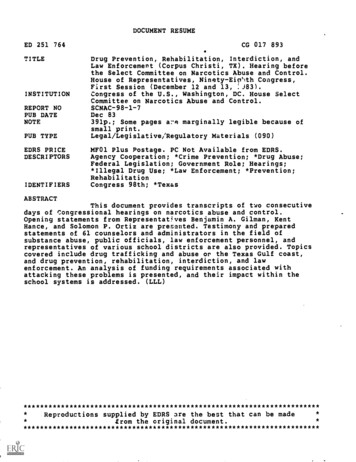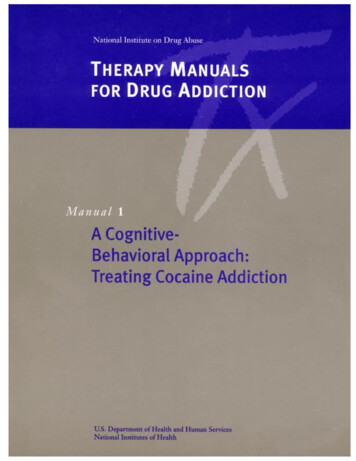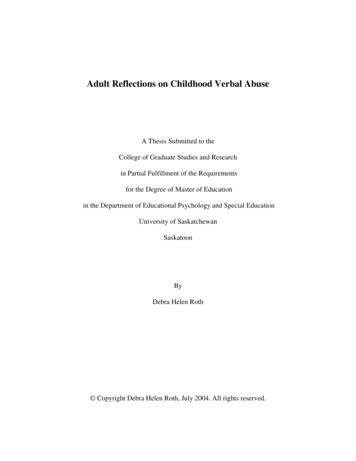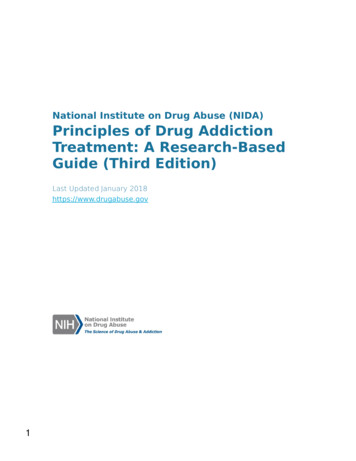
Transcription
National Institute on Drug Abuse (NIDA)Principles of Drug AddictionTreatment: A Research-BasedGuide (Third Edition)Last Updated January 2018https://www.drugabuse.gov1
Table of ContentsPrinciples of Drug Addiction Treatment: A Research-Based Guide (ThirdEdition)PrefacePrinciples of Effective TreatmentFrequently Asked QuestionsDrug Addiction Treatment in the United StatesEvidence-Based Approaches to Drug Addiction TreatmentResourcesAcknowledgments2
PrefaceDrug addiction is a complex illness.It is characterized by intense and, at times, uncontrollable drugcraving, along with compulsive drug seeking and use that persist evenin the face of devastating consequences. This update of the NationalInstitute on Drug Abuse’s Principles of Drug Addiction Treatment isintended to address addiction to a wide variety of drugs, includingnicotine, alcohol, and illicit and prescription drugs. It is designed toserve as a resource for healthcare providers, family members, andother stakeholders trying to address the myriad problems faced bypatients in need of treatment for drug abuse or addiction.Addiction affects multiple brain circuits, including those involved inreward and motivation, learning and memory, and inhibitory controlover behavior. That is why addiction is a brain disease. Someindividuals are more vulnerable than others to becoming addicted,depending on the interplay between genetic makeup, age of exposureto drugs, and other environmental influences. While a person initiallychooses to take drugs, over time the effects of prolonged exposure onbrain functioning compromise that ability to choose, and seeking andconsuming the drug become compulsive, often eluding a person’s selfcontrol or willpower.But addiction is more than just compulsive drug taking—it can alsoproduce far-reaching health and social consequences. For example,drug abuse and addiction increase a person’s risk for a variety of othermental and physical illnesses related to a drug-abusing lifestyle or thetoxic effects of the drugs themselves. Additionally, the dysfunctionalbehaviors that result from drug abuse can interfere with a person’snormal functioning in the family, the workplace, and the broadercommunity.Because drug abuse and addiction have so many dimensions and3
disrupt so many aspects of an individual’s life, treatment is not simple.Effective treatment programs typically incorporate many components,each directed to a particular aspect of the illness and its consequences.Addiction treatment must help the individual stop using drugs,maintain a drug-free lifestyle, and achieve productive functioning inthe family, at work, and in society. Because addiction is a disease, mostpeople cannot simply stop using drugs for a few days and be cured.Patients typically require long-term or repeated episodes of care toachieve the ultimate goal of sustained abstinence and recovery of theirlives. Indeed, scientific research and clinical practice demonstrate thevalue of continuing care in treating addiction, with a variety ofapproaches having been tested and integrated in residential andcommunity settings.As we look toward the future, we will harness new research results onthe influence of genetics and environment on gene function andexpression (i.e., epigenetics), which are heralding the development ofpersonalized treatment interventions. These findings will be integratedwith current evidence supporting the most effective drug abuse andaddiction treatments and their implementation, which are reflected inthis guide.Nora D. Volkow, M.D.DirectorNational Institute on Drug Abuse4
Principles of EffectiveTreatment1. Addiction is a complex but treatable disease that affectsbrain function and behavior. Drugs of abuse alter the brain’sstructure and function, resulting in changes that persist long afterdrug use has ceased. This may explain why drug abusers are atrisk for relapse even after long periods of abstinence and despitethe potentially devastating consequences.2. No single treatment is appropriate for everyone. Treatmentvaries depending on the type of drug and the characteristics ofthe patients. Matching treatment settings, interventions, andservices to an individual’s particular problems and needs is criticalto his or her ultimate success in returning to productivefunctioning in the family, workplace, and society.3. Treatment needs to be readily available. Because drugaddicted individuals may be uncertain about entering treatment,taking advantage of available services the moment people areready for treatment is critical. Potential patients can be lost iftreatment is not immediately available or readily accessible. Aswith other chronic diseases, the earlier treatment is offered in thedisease process, the greater the likelihood of positive outcomes.4. Effective treatment attends to multiple needs of theindividual, not just his or her drug abuse. To be effective,treatment must address the individual’s drug abuse and anyassociated medical, psychological, social, vocational, and legalproblems. It is also important that treatment be appropriate to theindividual’s age, gender, ethnicity, and culture.5. Remaining in treatment for an adequate period of time iscritical. The appropriate duration for an individual depends onthe type and degree of the patient’s problems and needs.Research indicates that most addicted individuals need at least 3months in treatment to significantly reduce or stop their drug useand that the best outcomes occur with longer durations of5
treatment. Recovery from drug addiction is a long-term processand frequently requires multiple episodes of treatment. As withother chronic illnesses, relapses to drug abuse can occur andshould signal a need for treatment to be reinstated or adjusted.Because individuals often leave treatment prematurely, programsshould include strategies to engage and keep patients intreatment.6. Behavioral therapies—including individual, family, or groupcounseling—are the most commonly used forms of drugabuse treatment. Behavioral therapies vary in their focus andmay involve addressing a patient’s motivation to change,providing incentives for abstinence, building skills to resist druguse, replacing drug-using activities with constructive andrewarding activities, improving problem-solving skills, andfacilitating better interpersonal relationships. Also, participation ingroup therapy and other peer support programs during andfollowing treatment can help maintain abstinence.7. Medications are an important element of treatment formany patients, especially when combined with counselingand other behavioral therapies. For example, methadone,buprenorphine, and naltrexone (including a new long-actingformulation) are effective in helping individuals addicted to heroinor other opioids stabilize their lives and reduce their illicit druguse. Acamprosate, disulfiram, and naltrexone are medicationsapproved for treating alcohol dependence. For persons addicted tonicotine, a nicotine replacement product (available as patches,gum, lozenges, or nasal spray) or an oral medication (such asbupropion or varenicline) can be an effective component oftreatment when part of a comprehensive behavioral treatmentprogram.8. An individual's treatment and services plan must beassessed continually and modified as necessary to ensurethat it meets his or her changing needs. A patient mayrequire varying combinations of services and treatmentcomponents during the course of treatment and recovery. Inaddition to counseling or psychotherapy, a patient may require6
medication, medical services, family therapy, parentinginstruction, vocational rehabilitation, and/or social and legalservices. For many patients, a continuing care approach providesthe best results, with the treatment intensity varying according toa person’s changing needs.9. Many drug-addicted individuals also have other mentaldisorders. Because drug abuse and addiction—both of which aremental disorders—often co-occur with other mental illnesses,patients presenting with one condition should be assessed for theother(s). And when these problems co-occur, treatment shouldaddress both (or all), including the use of medications asappropriate.10. Medically assisted detoxification is only the first stage ofaddiction treatment and by itself does little to changelong-term drug abuse. Although medically assisteddetoxification can safely manage the acute physical symptoms ofwithdrawal and can, for some, pave the way for effective longterm addiction treatment, detoxification alone is rarely sufficientto help addicted individuals achieve long-term abstinence. Thus,patients should be encouraged to continue drug treatmentfollowing detoxification. Motivational enhancement and incentivestrategies, begun at initial patient intake, can improve treatmentengagement.11. Treatment does not need to be voluntary to be effective.Sanctions or enticements from family, employment settings,and/or the criminal justice system can significantly increasetreatment entry, retention rates, and the ultimate success of drugtreatment interventions.12. Drug use during treatment must be monitoredcontinuously, as lapses during treatment do occur. Knowingtheir drug use is being monitored can be a powerful incentive forpatients and can help them withstand urges to use drugs.Monitoring also provides an early indication of a return to druguse, signaling a possible need to adjust an individual’s treatmentplan to better meet his or her needs.7
13. Treatment programs should test patients for the presenceof HIV/AIDS, hepatitis B and C, tuberculosis, and otherinfectious diseases as well as provide targeted riskreduction counseling, linking patients to treatment ifnecessary. Typically, drug abuse treatment addresses some ofthe drug-related behaviors that put people at risk of infectiousdiseases. Targeted counseling focused on reducing infectiousdisease risk can help patients further reduce or avoid substancerelated and other high-risk behaviors. Counseling can also helpthose who are already infected to manage their illness. Moreover,engaging in substance abuse treatment can facilitate adherenceto other medical treatments. Substance abuse treatment facilitiesshould provide onsite, rapid HIV testing rather than referrals tooffsite testing—research shows that doing so increases thelikelihood that patients will be tested and receive their test results.Treatment providers should also inform patients that highly activeantiretroviral therapy (HAART) has proven effective in combatingHIV, including among drug-abusing populations, and help linkthem to HIV treatment if they test positive.8
Frequently Asked QuestionsTreatment varies depending on the type of drug and thecharacteristics of the patient. The best programs provide acombination of therapies and other services.Why do drug-addicted personskeep using drugs?Nearly all addicted individuals believe at the outset that they can stopusing drugs on their own, and most try to stop without treatment.Although some people are successful, many attempts result in failureto achieve long-term abstinence. Research has shown that long-termdrug abuse results in changes in the brain that persist long after aperson stops using drugs. These drug-induced changes in brainfunction can have many behavioral consequences, including aninability to exert control over the impulse to use drugs despite adverseconsequences—the defining characteristic of addiction.Long-term drug use results in significant changes in brain functionthat can persist long after the individual stops using drugs.Understanding that addiction has such a fundamental biologicalcomponent may help explain the difficulty of achieving andmaintaining abstinence without treatment. Psychological stress fromwork, family problems, psychiatric illness, pain associated with medicalproblems, social cues (such as meeting individuals from one’s drugusing past), or environmental cues (such as encountering streets,objects, or even smells associated with drug abuse) can trigger intensecravings without the individual even being consciously aware of thetriggering event. Any one of these factors can hinder attainment of9
sustained abstinence and make relapse more likely. Nevertheless,research indicates that active participation in treatment is an essentialcomponent for good outcomes and can benefit even the most severelyaddicted individuals.What is drug addiction treatment?Drug treatment is intended to help addicted individuals stopcompulsive drug seeking and use. Treatment can occur in a variety ofsettings, take many different forms, and last for different lengths oftime. Because drug addiction is typically a chronic disordercharacterized by occasional relapses, a short-term, one-time treatmentis usually not sufficient. For many, treatment is a long-term processthat involves multiple interventions and regular monitoring.There are a variety of evidence-based approaches to treating addiction.Drug treatment can include behavioral therapy (such as cognitivebehavioral therapy or contingency management), medications, or theircombination. The specific type of treatment or combination of10
treatments will vary depending on the patient’s individual needs and,often, on the types of drugs they use.Drug addiction treatment can include medications, behavioraltherapies, or their combination.Treatment medications, such as methadone, buprenorphine, andnaltrexone (including a new long-acting formulation), are available forindividuals addicted to opioids, while nicotine preparations (patches,gum, lozenges, and nasal spray) and the medications varenicline andbupropion are available for individuals addicted to tobacco. Disulfiram,acamprosate, and naltrexone are medications available for treatingalcohol dependence,1 which commonly co-occurs with other drugaddictions, including addiction to prescription medications.Treatments for prescription drug abuse tend to be similar to those forillicit drugs that affect the same brain systems. For example,buprenorphine, used to treat heroin addiction, can also be used to treataddiction to opioid pain medications. Addiction to prescriptionstimulants, which affect the same brain systems as illicit stimulants likecocaine, can be treated with behavioral therapies, as there are not yetmedications for treating addiction to these types of drugs.Behavioral therapies can help motivate people to participate in drugtreatment, offer strategies for coping with drug cravings, teach ways toavoid drugs and prevent relapse, and help individuals deal with relapseif it occurs. Behavioral therapies can also help people improvecommunication, relationship, and parenting skills, as well as familydynamics.Many treatment programs employ both individual and group therapies.Group therapy can provide social reinforcement and help enforcebehavioral contingencies that promote abstinence and a non-drugusing lifestyle. Some of the more established behavioral treatments,11
such as contingency management and cognitive-behavioral therapy,are also being adapted for group settings to improve efficiency andcost-effectiveness. However, particularly in adolescents, there can alsobe a danger of unintended harmful (or iatrogenic) effects of grouptreatment—sometimes group members (especially groups of highlydelinquent youth) can reinforce drug use and thereby derail thepurpose of the therapy. Thus, trained counselors should be aware ofand monitor for such effects.Because they work on different aspects of addiction, combinations ofbehavioral therapies and medications (when available) generallyappear to be more effective than either approach used alone.Finally, people who are addicted to drugs often suffer from other health(e.g., depression, HIV), occupational, legal, familial, and socialproblems that should be addressed concurrently. The best programsprovide a combination of therapies and other services to meet anindividual patient’s needs. Psychoactive medications, such asantidepressants, anti-anxiety agents, mood stabilizers, andantipsychotic medications, may be critical for treatment success whenpatients have co-occurring mental disorders such as depression,anxiety disorders (including post-traumatic stress disorder), bipolardisorder, or schizophrenia. In addition, most people with severeaddiction abuse multiple drugs and require treatment for allsubstances abused.Treatment for drug abuse and addiction is delivered in manydifferent settings using a variety of behavioral andpharmacological approaches.1Anotherdrug, topiramate, has also shown promise in studies and issometimes prescribed (off-label) for this purpose although it has notreceived FDA approval as a treatment for alcohol dependence.12
How effective is drug addictiontreatment?In addition to stopping drug abuse, the goal of treatment is to returnpeople to productive functioning in the family, workplace, andcommunity. According to research that tracks individuals in treatmentover extended periods, most people who get into and remain intreatment stop using drugs, decrease their criminal activity, andimprove their occupational, social, and psychological functioning. Forexample, methadone treatment has been shown to increaseparticipation in behavioral therapy and decrease both drug use andcriminal behavior. However, individual treatment outcomes depend onthe extent and nature of the patient’s problems, the appropriateness oftreatment and related services used to address those problems, andthe quality of interaction between the patient and his or her treatmentproviders.Relapse rates for addiction resemble those of other chronicdiseases such as diabetes, hypertension, and asthma.Like other chronic diseases, addiction can be managed successfully.Treatment enables people to counteract addiction’s powerful disruptiveeffects on the brain and behavior and to regain control of their lives.The chronic nature of the disease means that relapsing to drug abuseis not only possible but also likely, with symptom recurrence ratessimilar to those for other well-characterized chronic medical illnesses—such as diabetes, hypertension, and asthma (see figure, "Comparisonof Relapse Rates Between Drug Addiction and Other Chronic Illnesses”)—that also have both physiological and behavioral components.13
Unfortunately, when relapse occurs many deem treatment a failure.This is not the case: Successful treatment for addiction typicallyrequires continual evaluation and modification as appropriate, similarto the approach taken for other chronic diseases. For example, when apatient is receiving active treatment for hypertension and symptomsdecrease, treatment is deemed successful, even though symptomsmay recur when treatment is discontinued. For the addicted individual,lapses to drug abuse do not indicate failure—rather, they signify thattreatment needs to be reinstated or adjusted, or that alternatetreatment is needed (see figure, "Why is Addiction Treatment EvaluatedDifferently?").14
Is drug addiction treatment worthits cost?Substance abuse costs our Nation over 600 billion annually andtreatment can help reduce these costs. Drug addiction treatment hasbeen shown to reduce associated health and social costs by far morethan the cost of the treatment itself. Treatment is also much lessexpensive than its alternatives, such as incarcerating addicted persons.For example, the average cost for 1 full year of methadonemaintenance treatment is approximately 4,700 per patient, whereas 1full year of imprisonment costs approximately 24,000 per person.Drug addiction treatment reduces drug use and its associatedhealth and social costs.According to several conservative estimates, every dollar invested inaddiction treatment programs yields a return of between 4 and 7 inreduced drug-related crime, criminal justice costs, and theft. Whensavings related to healthcare are included, total savings can exceed15
costs by a ratio of 12 to 1. Major savings to the individual and tosociety also stem from fewer interpersonal conflicts; greater workplaceproductivity; and fewer drug-related accidents, including overdosesand deaths.How long does drug addictiontreatment usually last?Individuals progress through drug addiction treatment at various rates,so there is no predetermined length of treatment. However, researchhas shown unequivocally that good outcomes are contingent onadequate treatment length. Generally, for residential or outpatienttreatment, participation for less than 90 days is of limitedeffectiveness, and treatment lasting significantly longer isrecommended for maintaining positive outcomes. For methadonemaintenance, 12 months is considered the minimum, and some opioidaddicted individuals continue to benefit from methadone maintenancefor many years.Good outcomes are contingent on adequate treatment length.Treatment dropout is one of the major problems encountered bytreatment programs; therefore, motivational techniques that can keeppatients engaged will also improve outcomes. By viewing addiction asa chronic disease and offering continuing care and monitoring,programs can succeed, but this will often require multiple episodes oftreatment and readily readmitting patients that have relapsed.What helps people stay intreatment?Because successful outcomes often depend on a person’s staying in16
treatment long enough to reap its full benefits, strategies for keepingpeople in treatment are critical. Whether a patient stays in treatmentdepends on factors associated with both the individual and theprogram. Individual factors related to engagement and retentiontypically include motivation to change drug-using behavior; degree ofsupport from family and friends; and, frequently, pressure from thecriminal justice system, child protection services, employers, or family.Within a treatment program, successful clinicians can establish apositive, therapeutic relationship with their patients. The clinicianshould ensure that a treatment plan is developed cooperatively withthe person seeking treatment, that the plan is followed, and thattreatment expectations are clearly understood. Medical, psychiatric,and social services should also be available.Whether a patient stays in treatment depends on factorsassociated with both the individual and the program.Because some problems (such as serious medical or mental illness orcriminal involvement) increase the likelihood of patients dropping outof treatment, intensive interventions may be required to retain them.After a course of intensive treatment, the provider should ensure atransition to less intensive continuing care to support and monitorindividuals in their ongoing recovery.How do we get more substanceabusing people into treatment?It has been known for many years that the "treatment gap” is massive—that is, among those who need treatment for a substance usedisorder, few receive it. In 2011, 21.6 million persons aged 12 or olderneeded treatment for an illicit drug or alcohol use problem, but only 2.3million received treatment at a specialty substance abuse facility.17
Reducing this gap requires a multipronged approach. Strategies includeincreasing access to effective treatment, achieving insurance parity(now in its earliest phase of implementation), reducing stigma, andraising awareness among both patients and healthcare professionalsof the value of addiction treatment. To assist physicians in identifyingtreatment need in their patients and making appropriate referrals,NIDA is encouraging widespread use of screening, brief intervention,and referral to treatment (SBIRT) tools for use in primary care settingsthrough its NIDAMED initiative. SBIRT, which evidence shows to beeffective against tobacco and alcohol use—and, increasingly, againstabuse of illicit and prescription drugs—has the potential not only tocatch people before serious drug problems develop, but also to identifypeople in need of treatment and connect them with appropriatetreatment providers.How can family and friends makea difference in the life of someoneneeding treatment?Family and friends can play critical roles in motivating individuals withdrug problems to enter and stay in treatment. Family therapy can alsobe important, especially for adolescents. Involvement of a familymember or significant other in an individual's treatment program canstrengthen and extend treatment benefits.Where can family members go forinformation on treatment options?Trying to locate appropriate treatment for a loved one, especiallyfinding a program tailored to an individual's particular needs, can be adifficult process. However, there are some resources to help with thisprocess. For example, NIDA’s handbook Seeking Drug AbuseTreatment: Know What to Ask offers guidance in finding the righttreatment program. Numerous online resources can help locate a local18
program or provide other information, including:The Substance Abuse and Mental Health Services Administration(SAMHSA) maintains a Web site (findtreatment.gov) that showsthe location of residential, outpatient, and hospital inpatienttreatment programs for drug addiction and alcoholism throughoutthe country. This information is also accessible by calling 1-800662-HELP.The National Suicide Prevention Lifeline (1-800-273-TALK) offersmore than just suicide prevention—it can also help with a host ofissues, including drug and alcohol abuse, and can connectindividuals with a nearby professional.The National Alliance on Mental Illness (www.nami.org) and MentalHealth America (www.mentalhealthamerica.net) are alliances ofnonprofit, self-help support organizations for patients and familiesdealing with a variety of mental disorders. Both have State andlocal affiliates throughout the country and may be especiallyhelpful for patients with comorbid conditions.The American Academy of Addiction Psychiatry and the AmericanAcademy of Child and Adolescent Psychiatry each have physicianlocator tools posted on their Web sites at aaap.org and aacap.org,respectively.Faces & Voices of Recovery (facesandvoicesofrecovery.org),founded in 2001, is an advocacy organization for individuals inlong-term recovery that strategizes on ways to reach out to themedical, public health, criminal justice, and other communities topromote and celebrate recovery from addiction to alcohol andother drugs.The Partnership at Drugfree.org (drugfree.org) is an organizationthat provides information and resources on teen drug use andaddiction for parents, to help them prevent and intervene in theirchildren’s drug use or find treatment for a child who needs it. Theyoffer a toll-free helpline for parents (1-855-378-4373).The American Society of Addiction Medicine (asam.org) is a19
society of physicians aimed at increasing access to addictiontreatment. Their Web site has a nationwide directory of addictionmedicine professionals.NIDA’s National Drug Abuse Treatment Clinical Trials /ctn) providesinformation for those interested in participating in a clinical trialtesting a promising substance abuse intervention; or visitclinicaltrials.gov.NIDA’s DrugPubs Research Dissemination Center(drugpubs.drugabuse.gov) provides booklets, pamphlets, factsheets, and other informational resources on drugs, drug abuse,and treatment.The National Institute on Alcohol Abuse and Alcoholism(niaaa.nih.gov) provides information on alcohol, alcohol use, andtreatment of alcohol-related problems(niaaa.nih.gov/search/node/treatment).How can the workplace play a rolein substance abuse treatment?Many workplaces sponsor Employee Assistance Programs (EAPs) thatoffer short-term counseling and/or assistance in linking employees withdrug or alcohol problems to local treatment resources, including peersupport/recovery groups. In addition, therapeutic work environmentsthat provide employment for drug-abusing individuals who candemonstrate abstinence have been shown not only to promote acontinued drug-free lifestyle but also to improve job skills, punctuality,and other behaviors necessary for active employment throughout life.Urine testing facilities, trained personnel, and workplace monitors areneeded to implement this type of treatment.20
What role can the criminal justicesystem play in addressing drugaddiction?It is estimated that about one-half of State and Federal prisoners abuseor are addicted to drugs, but relatively few receive treatment whileincarcerated. Initiating drug abuse treatment in prison and continuingit upon release is vital to both individual recovery and to public healthand safety. Various studies have shown that combining prison- andcommunity-based treatment for addicted offenders reduces the risk ofboth recidivism to drug-related criminal behavior and relapse to druguse—which, in turn, nets huge savings in societal costs. A 2009 studyin Baltimore, Maryland, for example, found that opioid-addictedprisoners who started methadone treatment (along with counseling) inprison and then continued it after release had better outcomes(reduced drug use and criminal activity) than those who only receivedcounseling while in prison or those who only started methadonetreatment after their release.Individuals who enter treatment under legal pressure haveoutcomes as favorable as those who enter treatment voluntarily.The majority of offenders involved with the criminal justice system arenot in prison but are under community supervision. For those withknown drug problems, drug addiction treatment may be recommendedor mandated as a condition of probation. Research has demonstratedthat individuals who enter treatment under legal pressure haveoutcomes as favorable as those who enter treatment voluntarily.The criminal justice system refers drug offenders into treatmentthrough a variety of mechanisms, such as diverting nonviolentoffenders to treatment; stipulating treatment as a condition ofincarceration, probation, or pretrial release; and conve
instruction, vocational rehabilitation, and/or social and legal services. For many patients, a continuing care approach provides the best results, with the treatment intensity varying according to a person's changing needs. 9. Many drug-addicted individuals also have other mental disorders. Because drug abuse and addiction—both of which are
